The Microsoft Lumia 640 Review
by Brandon Chester on June 9, 2015 8:00 AM EST- Posted in
- Smartphones
- Microsoft
- Mobile
- Lumia
- windows phone 8
Display
Smartphone displays have rapidly improved at every single price point. Inexpensive smartphones often compromised on display quality, which ended up hurting much of the overall experience. However, even inexpensive smartphones now ship with IPS displays and high enough resolutions to render text without overwhelming aliasing.
The Lumia 640 has a 5" 1280x720 IPS display. At 294 pixels per inch, it’s fairly sharp for a phone of this price. It’s obviously not some 2560x1440 flagship phone, but I never felt like text appeared fuzzy or highly aliased. To evaluated the aspects of display quality beyond what you’ll see on a spec sheet we turn to our standard smartphone display tests. As always, measurements are performed with X-Rite's i1Pro 2 spectrophotometer and SpectraCal's CalMAN 5 software, with the exception of contrast measurements which are done with an i1Display Pro colorimeter.
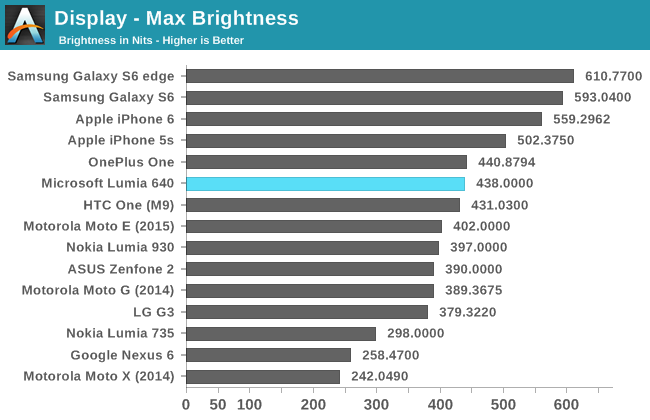
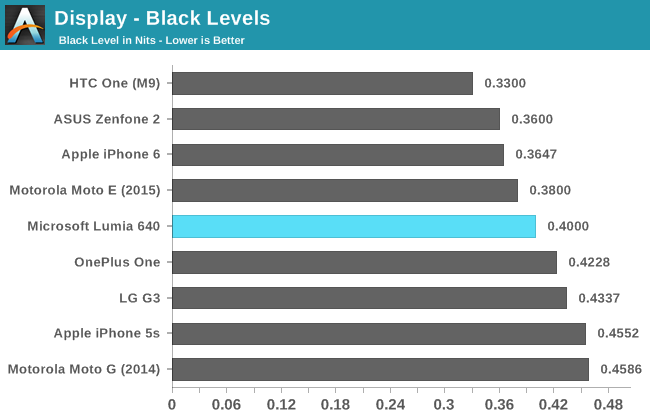
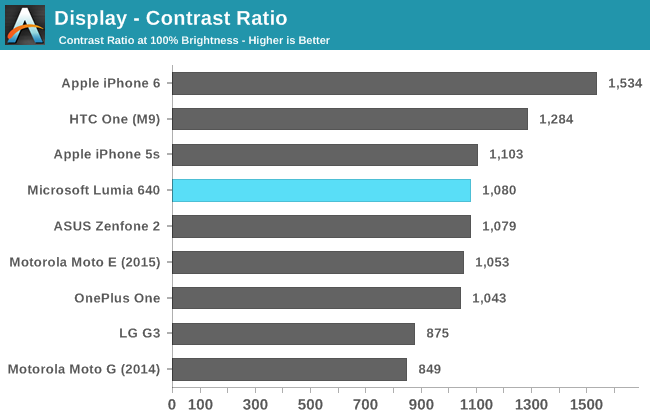
437 nits is a fairly good result for peak brightness. It’s not quite as high as the 500 and 600nit displays that you’ll see on flagship phones, but it’s noticeably higher than many other devices at this price point. The contrast is also pretty good. While the black level isn’t even close to the lowest we’ve seen, when you consider that many devices use CABC to cheat on contrast it’s actually a relatively good result.
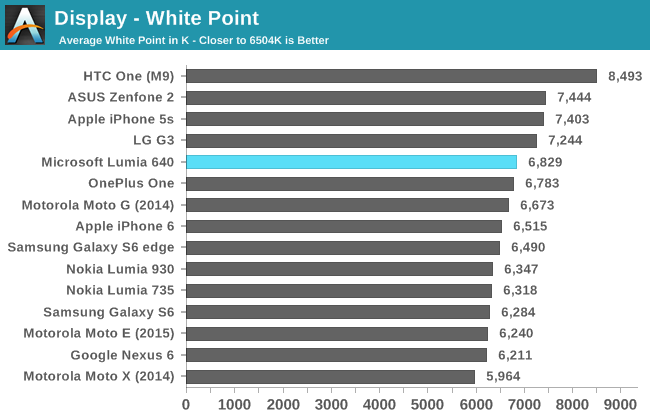
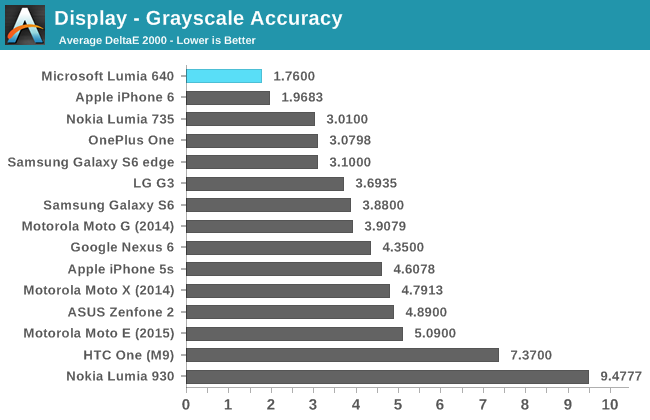
The greyscale results on the Lumia 640 are exceptional. RGB balance is great at every shade of grey, with only a very slight shift toward blue. All of the errors will only be visible if you compare static images with a reference monitor. There’s not much more to be said, as the greyscale accuracy on this display is essentially perfect.
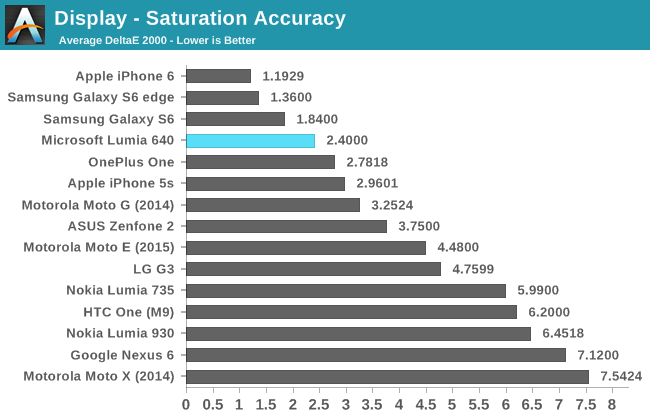
The next test examines saturations of primary and secondary colors on the display in increments of 20%. In this test the Lumia 640 does very well. There are definitely some issues with blue and magenta, and the fact that cyan maxes out at 80% saturation, but the overall accuracy is very good.
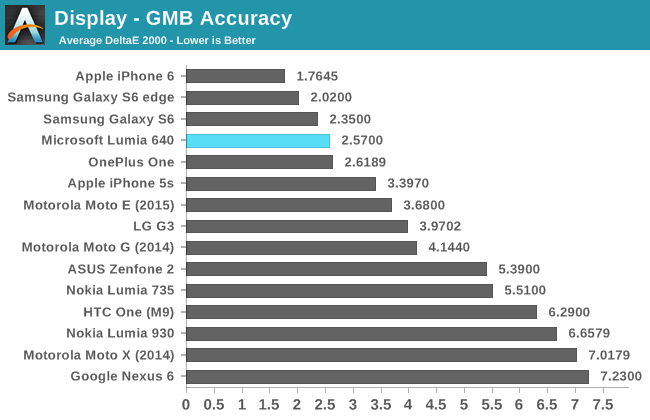
The final display benchmark is the Gretag MacBeth ColorChecker test. This test examines colors that are commonly found in the real world, and it’s the best benchmark of display color rendition. A display can hit its saturation targets accurately but fail to reproduce these color mixtures properly.
Fortunately, the Lumia 640 suffers from no such issues. Most of the colors are reproduced with a high degree of accuracy, with the big errors being in shades of blue. Skin tones are very well reproduced, which is something I’ve seen other devices struggling with in recent reviews.
Overall, the Lumia 640’s display is very good, and I would go as far as to say that it’s one of the best displays on a phone at this price point. It performs well in every category, from brightness, to contrast, to color accuracy, and the resolution is high enough to keep everything looking fairly sharp. I think Lumia 640 users will be very happy with the display on their phone.


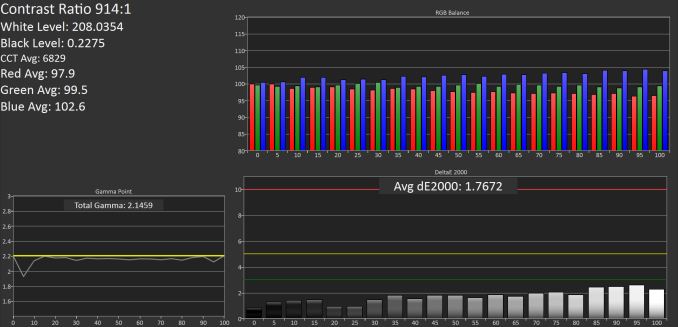











130 Comments
View All Comments
kevloral - Tuesday, June 9, 2015 - link
"After declining sales of Symbian devices, the company decided to go all in with Microsoft's Windows Phone platform"Why is this false mantra repeated again and again? When Nokia decided to go Windows Phone, Symbian devices were being sold more than ever. Just check the statistics from the time.
danbob999 - Tuesday, June 9, 2015 - link
Declining market share.niva - Tuesday, June 9, 2015 - link
Nokia used to be to the cell phone market kind of what Apple has become today. It's amazing how quickly they failed and were never able to recover. Failing to jump on the Android bandwagon early ultimately led to their demise.Brandon Chester - Tuesday, June 9, 2015 - link
That's not true. Reports from Gartner and IDC both agree that Nokia shipped significantly fewer devices in each quarter of 2011 than that same quarter in 2010.hemedans - Tuesday, June 9, 2015 - link
last symbian flagship was nokia n8 which come out 2010, in 2011 n9 was nokia flagship and 2012 we saw lumia 900 and 920.last s60v3 were nokia c5 and e5 both of them come out 2010, elop killed symbian at low end in favour of nokia asha. symbian was killed by nokia before the official anouncement in 2012.
Cryio - Tuesday, June 9, 2015 - link
Last Symbian Flagship was the 808 which launched in 2012.hemedans - Wednesday, June 10, 2015 - link
808 was niche device to introduce nokia camera capability, at that time nokia already anounce symbian was dead platform. in 2012 nokia 900 and 920 were nokia flagshipPenti - Tuesday, June 9, 2015 - link
They had effectively already killed Symbian early 2011 and sales didn't decline until the burning platform memo, plus canceling already announced/showed phones and giving up on Symbian development, which they transfered to Accenture already in the summer which later fired almost everybody within a year or so. By the time the N9 was out/showed they had made it clear the platform (MeeGo/Harmattan) was dead before the phone shipped and wouldn't receive any major updates or any new development.Penti - Tuesday, June 9, 2015 - link
They didn't really have a WP device of their own until Lumia 900 either. Lumia 800 was a Clevo-built/designed device. Thus they had nothing to sell between feb 2011 and april-june 2012 at all that they hadn't decided to stop development of and spoken out against. Neither did they have a WP8 device until November 2012.Klimax - Saturday, June 13, 2015 - link
Sales at the cost of profits. They made near zero on them as they HAD to make them extremely cheap. Otherwise you'd see sales going down much sooner and much faster.Symbian was dead, it just didn't noticed it for short time...